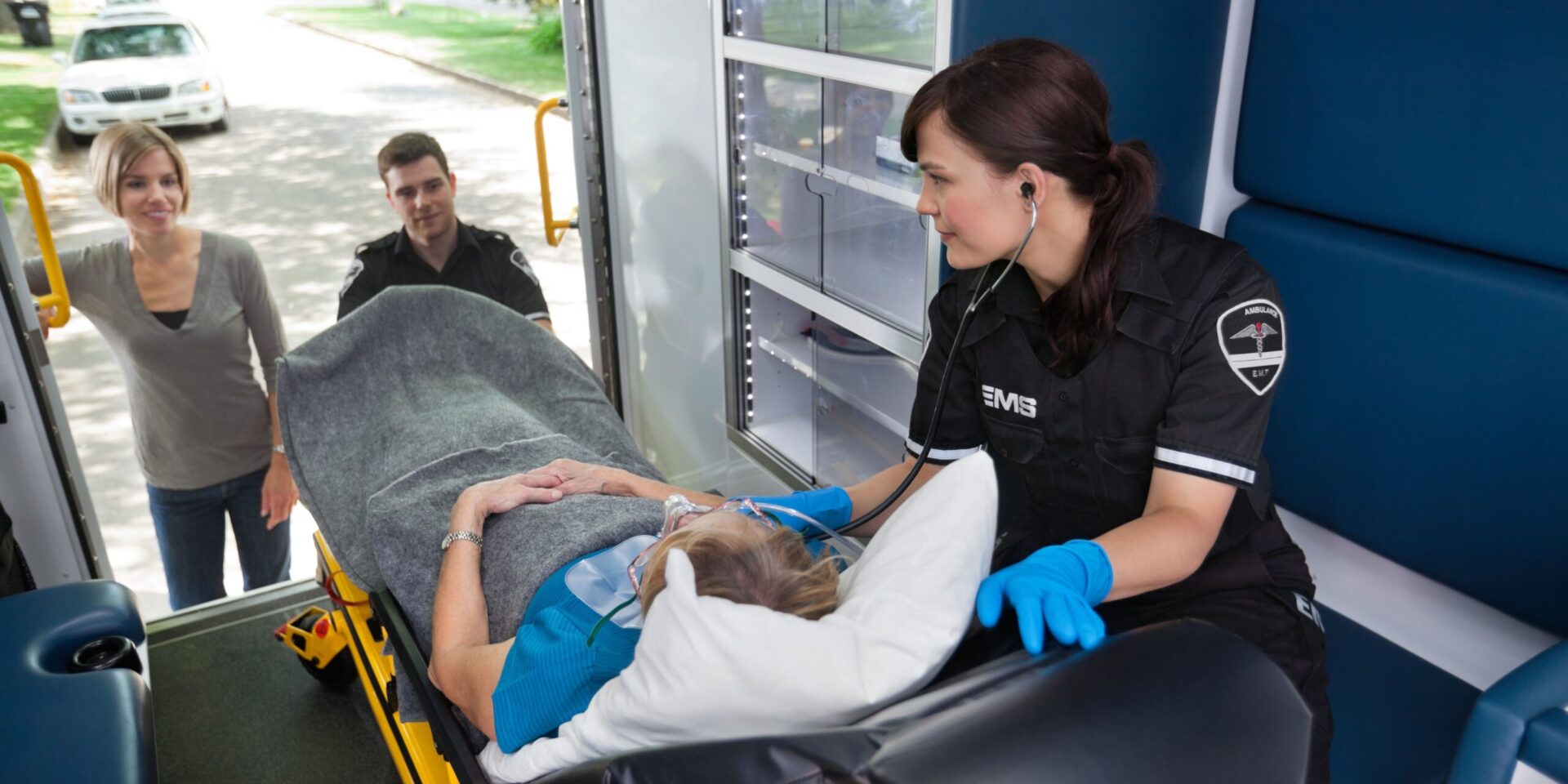Language:
How to Start a Medical Transportation Business

Think about how simple it may be for you to get to the grocery store, pick up your kid from school, or head to a yoga class. But for senior citizens and people with disabilities, what’s simple to you could be a trek to them. That’s when non-emergency medical transportation or NEMT businesses come into play!
If you have a passion for helping others and have experience or interest in driving or managing vehicles, you can drive your passion into a profitable business with a NEMT transportation business.
Is the Medical Transportation Business for You?
What is a medical transportation business? Think of a NEMT transport business as a specialized taxi service for those with disabilities. Through a specialized vehicle, you’re taking riders to healthcare appointments, grocery stores, and other places they wouldn’t be able to go to on their own.
Who needs it? Senior citizens, wheelchair users, those struggling with obesity, and people who are disabled, impaired, or have special needs (like those who have severe motor tics from Tourettes or epilepsy) all can use a NEMT transportation service to make their lives easier.
How Much Does it Cost to Start a Medical Transportation Business?
There are always general expenses for starting a business, like the cost of forming in your state (which can be a few hundred dollars) and a computer or office space if you don’t have one. For NEMT transportation services specifically, consider the biggest costs:
The Vehicle— Unlike driving a Lyft or Uber, a NEMT vehicle needs to be big enough to support designated medical supplies and the transporters themselves and be completely ADA accessible (Americans with Disabilities Act). The basic requirements to be ADA accessible vary based on the vehicle and your specific business, but they include things like a lift or a ramp for riders to get in, slip-resistant surfaces, and compliant lighting. This can range from $50,000-$70,000, depending on if you purchase a new or used vehicle.
The Equipment— All NEMT vehicles require certain equipment depending on the state you live in. These might include things like walkers, gurneys, oxygen tanks, and wheelchairs. Check your state regulations to get a full comprehensive list and an understanding of the price range.
Insurance— To protect your business from accidents, you’ll need a great insurance policy. Monthly rates for commercial auto insurance could be a few hundred dollars a month to protect riders and keep your business safe.
8 Steps to Starting a Medical Transportation Business
If you’re excited to help people get around, then let’s steer into how to start your NEMT business.
1. Find a Market and Location Fit
Before starting anything, identify the actual need for NEMT transportation providers in your area. Analyze the number of people with disabilities and whether they’re struggling to get around with the current lack of driving services. If you find that there isn’t much of a need in your area, expand your map a bit further— as long as the gas expenses are still worth the trip. Take into account other factors, like where you’ll park it when it’s not in use, how much gas will cost if you’re traveling further distances, and what your rates will need to be to fit the location.
2. Create a Business Plan
Creating a business plan will help outline the details of your business like your scaling strategy, business operations and rules, and permits and licenses you’ll collect before starting. Business plans set a clear direction for your NEMT business, from how you’ll receive payments to how you’ll turn your one-van business into a whole fleet serving multiple counties!
3. Identify Your Investments and Establish Funding
You’ve found a product-market fit for your medical transportation business and are ready to continue driving down the road of business start-up. Before you continue, take a good look at your wallet. Do you have money to fund this venture, or do you want to take out a business loan?
There are a few ways to determine your funding— if you have enough money to start it up yourself, then you won’t owe interest by borrowing. If you don’t, then explore options to get a small business loan. Small business loans can come from national banks, credit unions, federal programs like the Small Business Administration (SBA), or private programs through other businesses or nonprofits that award loan offerings to new business owners. Research the options in your area, and consider factors like APR, loan limit, and whether you’re required to have a certain amount of time in business.
No matter what your funding is, create a budget for yourself that works with your current income and expenses.
4. Decide Your Business Entity Type
Now is the time to officiate your business entity type. It’ll legitimize your business when you apply, That way, you can separate your business expenses from your personal expenses and better monitor your income and expenditures from your NEMT business.
Sole Proprietorship— An unincorporated business type where a business owner’s personal assets are directly attached to their business. While there’s no setup cost needed, it does yield a bigger risk if something legal were to happen.
General Partnership— An unincorporated business structure with two or more owners whose personal liabilities are connected to their business. This poses the same risk as a sole proprietorship, just with more owners (members).
Limited Liability Company (LLC)— An incorporated business that separates a business owner’s personal assets from their business. This is the same liability protection as a Limited Liability Partnership (LLP).
S Corporation (S-corp)— An incorporated business structure that an LLC can file come tax season. There are multiple shareholders in this company (less than 100) compared to LLCs.
5. Apply
NEMT businesses are required to apply to become official NEMT vehicles so they can qualify as a Medicaid agency— meaning riders can reap the benefits of using their Medicaid benefits to pay for your services. Each state has a different application, so type “NEMT application [your state]” into your browser to find your state’s application.
6. Open a Business Bank Account
If you haven’t checked this off yet, go ahead and find a business bank account to separate your personal expenditures from your business expenditures. Research bank accounts that don’t ask for large transfer fees to help you get off the ground without being charged for everything you intake.
7. Recruit and Train Drivers
Think about what you wrote down in your business plan, particularly when it comes to scaling. Do you see just yourself driving, or do you envision multiple drivers working for your business? if you’re starting with a few vehicles, you can start hiring early if your business allows it. Send out job postings on local Facebook groups or your neighborhood NextDoor app or ask friends you think may be interested in driving.
Your business plan should include an overview of how you’d like your business to run, including how drivers interact with riders, and where to find an operations manual to work the equipment.
8. Run Your Business and Measure Results
Now that you have everything up and running, track every metric you can think of. Is the price you’re charging making up for the price paid in gas to get around? How much are you earning per day, and how much are you spending?
Utilize tracking tools and software to make it easier for riders to pay, like TripSpark, or NEMT Pro to make your vehicle more reliable and flexible with trip assignments and updates.
Most importantly, know that tools and programs are available to make your business flow even easier!
Start Your NEMT Business with doola’s Help
Whether you’re starting with a single van or a whole fleet, let doola help you form, run, and grow your medical transportation business. Our bookkeeping services can help you track and manage your finances while you’re on the road, so each month, you’re welcomed with a tailored financial report on your business. Happy driving!
FAQs
How profitable is a medical transportation business?
You can make a medical transportation business profitable if you charge accordingly, budget your vehicle properly, and have a strategic scaling plan so you’re always ensuring your business is profitable while not getting too overwhelming.
What are the taxes for a medical transportation business?
Just like in other businesses, you have to pay taxes on most everything for your medical transportation business; however, just like in other businesses, you’ll have lots of write-off opportunities on business expenses, some of the largest being gas, car upkeep, and hiring other drivers!
Is it hard to start a medical transport business?
Any business takes upfront work to get started, and medical transport businesses are no different. The biggest investment you’ll make will probably be the vehicle(s) that’ll (literally) drive your business!
Keep reading
Start your dream business and keep it 100% compliant
Turn your dream idea into your dream business.















